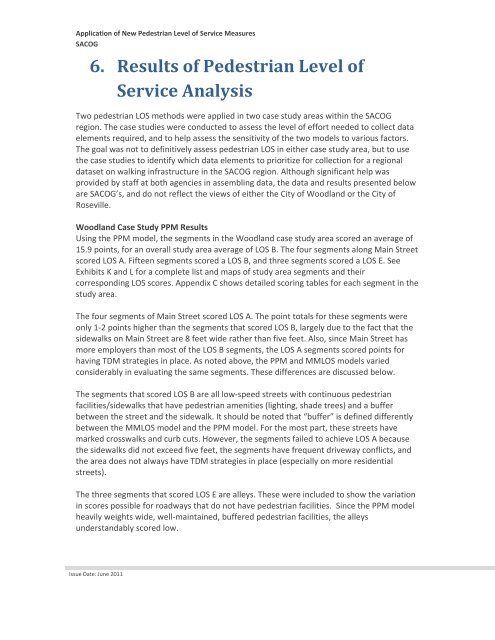Application of New Pedestrian Level of Service Measures - sacog
Application of New Pedestrian Level of Service Measures - sacog
Application of New Pedestrian Level of Service Measures - sacog
Create successful ePaper yourself
Turn your PDF publications into a flip-book with our unique Google optimized e-Paper software.
<strong>Application</strong> <strong>of</strong> <strong>New</strong> <strong>Pedestrian</strong> <strong>Level</strong> <strong>of</strong> <strong>Service</strong> <strong>Measures</strong><br />
SACOG<br />
6. Results <strong>of</strong> <strong>Pedestrian</strong> <strong>Level</strong> <strong>of</strong><br />
<strong>Service</strong> Analysis<br />
Two pedestrian LOS methods were applied in two case study areas within the SACOG<br />
region. The case studies were conducted to assess the level <strong>of</strong> effort needed to collect data<br />
elements required, and to help assess the sensitivity <strong>of</strong> the two models to various factors.<br />
The goal was not to definitively assess pedestrian LOS in either case study area, but to use<br />
the case studies to identify which data elements to prioritize for collection for a regional<br />
dataset on walking infrastructure in the SACOG region. Although significant help was<br />
provided by staff at both agencies in assembling data, the data and results presented below<br />
are SACOG’s, and do not reflect the views <strong>of</strong> either the City <strong>of</strong> Woodland or the City <strong>of</strong><br />
Roseville.<br />
Woodland Case Study PPM Results<br />
Using the PPM model, the segments in the Woodland case study area scored an average <strong>of</strong><br />
15.9 points, for an overall study area average <strong>of</strong> LOS B. The four segments along Main Street<br />
scored LOS A. Fifteen segments scored a LOS B, and three segments scored a LOS E. See<br />
Exhibits K and L for a complete list and maps <strong>of</strong> study area segments and their<br />
corresponding LOS scores. Appendix C shows detailed scoring tables for each segment in the<br />
study area.<br />
The four segments <strong>of</strong> Main Street scored LOS A. The point totals for these segments were<br />
only 1‐2 points higher than the segments that scored LOS B, largely due to the fact that the<br />
sidewalks on Main Street are 8 feet wide rather than five feet. Also, since Main Street has<br />
more employers than most <strong>of</strong> the LOS B segments, the LOS A segments scored points for<br />
having TDM strategies in place. As noted above, the PPM and MMLOS models varied<br />
considerably in evaluating the same segments. These differences are discussed below.<br />
The segments that scored LOS B are all low‐speed streets with continuous pedestrian<br />
facilities/sidewalks that have pedestrian amenities (lighting, shade trees) and a buffer<br />
between the street and the sidewalk. It should be noted that “buffer” is defined differently<br />
between the MMLOS model and the PPM model. For the most part, these streets have<br />
marked crosswalks and curb cuts. However, the segments failed to achieve LOS A because<br />
the sidewalks did not exceed five feet, the segments have frequent driveway conflicts, and<br />
the area does not always have TDM strategies in place (especially on more residential<br />
streets).<br />
The three segments that scored LOS E are alleys. These were included to show the variation<br />
in scores possible for roadways that do not have pedestrian facilities. Since the PPM model<br />
heavily weights wide, well‐maintained, buffered pedestrian facilities, the alleys<br />
understandably scored low.<br />
Issue Date: June 2011
















